
Household Conveniences
Cellular phone was the most common household convenience/device as reported by about nine out of ten Filipino homes in Northern Mindanao, followed by television set at 76.7 percent, and radio at 54.1 percent. (Figure 1)
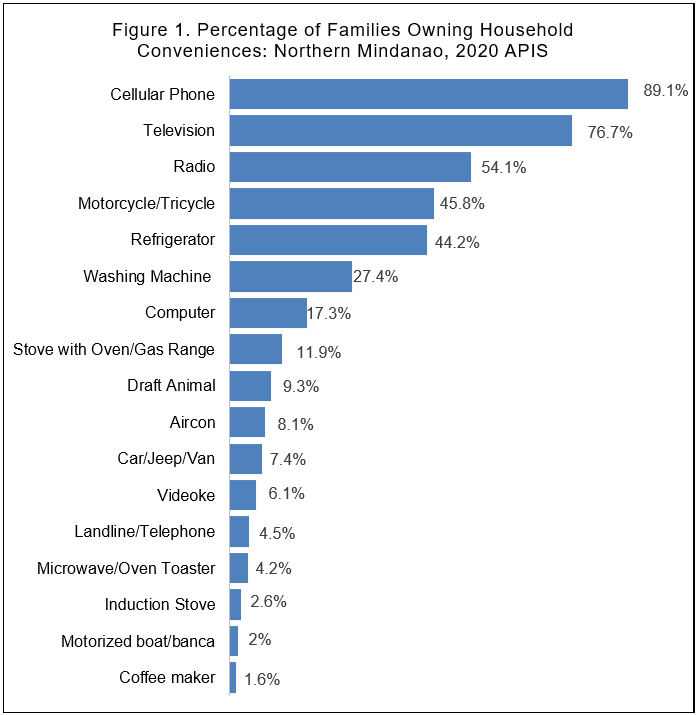
Subscription to Cable, Broadband Internet and Video Streaming Services
A quarter of the families in Northern Mindanao had subscription to cable network (e.g., Sky cable, Cignal, etc.), while 12.2 percent had subscription to broadband internet, fiber internet/DSL, and 3.9 percent had subscription to video streaming services (e.g., Netflix, iflix, iWantv, etc.). (Figure 2)
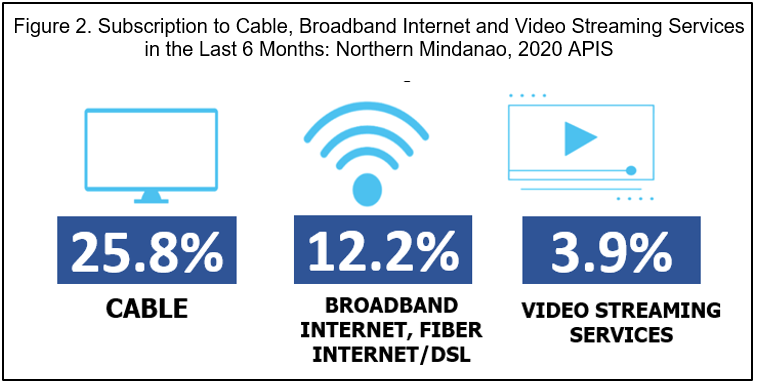
Electricity
The national coverage of electricity was at 94.5 percent. Whereas in Northern Mindanao, about 90.5 percent of families had electricity in their homes which was lower than the national coverage of electricity. (Figure 3)
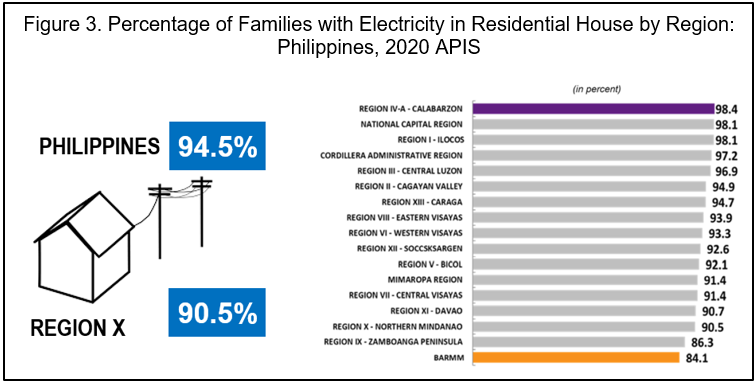
Internet and Online Transactions
The National Capital Region (66.6%) had the highest percentage of families who used the internet, followed by Region IV-A (62.9%). Northern Mindanao ranked third with 43.5 percent of families using internet in January to June 2020. (Figure 4)
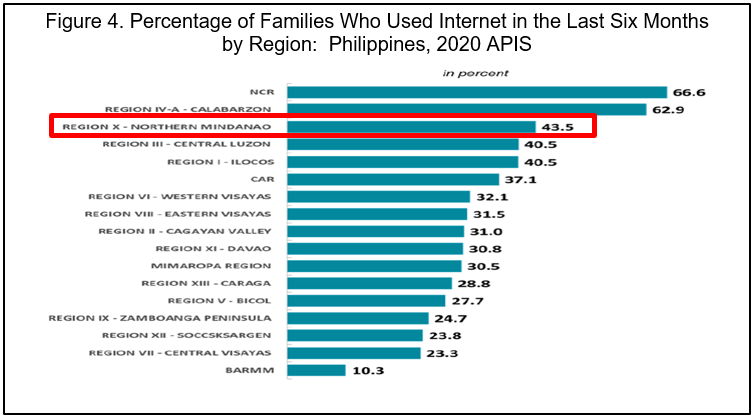
Online buying transaction using the internet (22.6%) was the most common online transaction made by the families in Northern Mindanao, followed by selling at 8.4 percent, bills payment at 6.1 percent, and banking at 4.5 percent. (Figure 5)
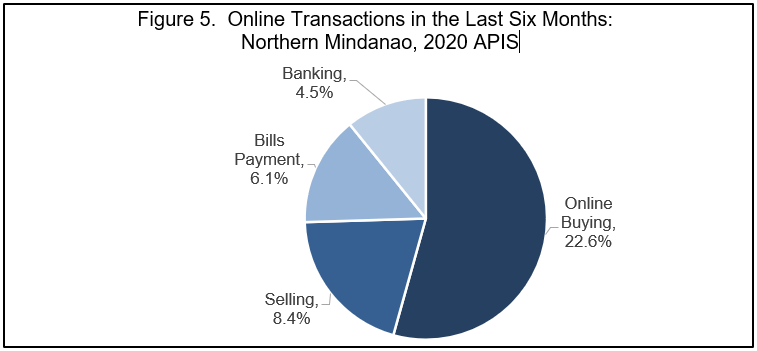
Sanitation Facility
In consonance with the SDG monitoring, sanitation has been classified according to service levels, namely: safely managed, basic, limited, unimproved, and open defecation.
About eight out of ten families had basic sanitation service level or used improved sanitation facility not shared with another household. Moreover, about one of ten families had limited-service level or equivalent to using an improved sanitation facility but shared with two or more households. The remaining 5.2 percent of families had an unimproved service level. Around 1.2 percent of families with no sanitation facility practice open defecation or disposal of human feces in fields, forest, bushes, open bodies of water, beaches and other open spaces or with solid waste. (Figure 6)
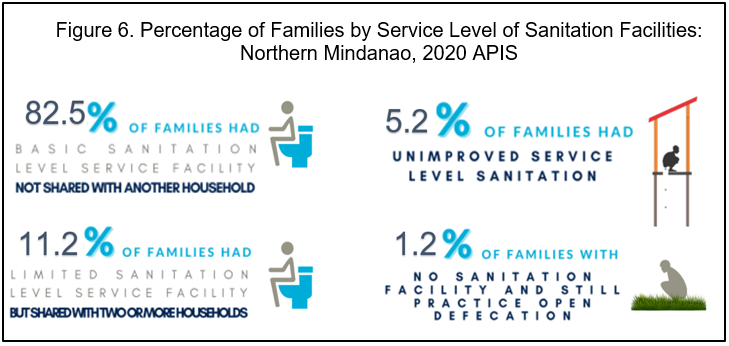
Handwashing
Nine out of ten families in Northern Mindanao had a hand washing facility on premises with soap and water. Families with hand washing facility on premises without soap and water was recorded at 6.5 percent, while 1.7 percent of families had no hand washing facility on premises. (Figure 7)
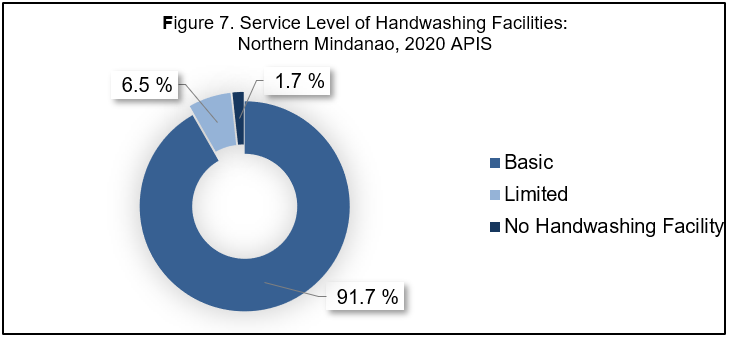
Drinking Water
Nine in every ten families in Northern Mindanao had basic service level with drinking water from an improved source for which collection time is not more than 30 minutes for a roundtrip including queuing. About 4.2 percent of families had limited service level with drinking water from an improved source for which collection time exceeds 30 minutes for a roundtrip including queuing, and 1.6 percent of families had unimproved service level with drinking water from an unprotected dug well or unprotected spring. (Figure 8)
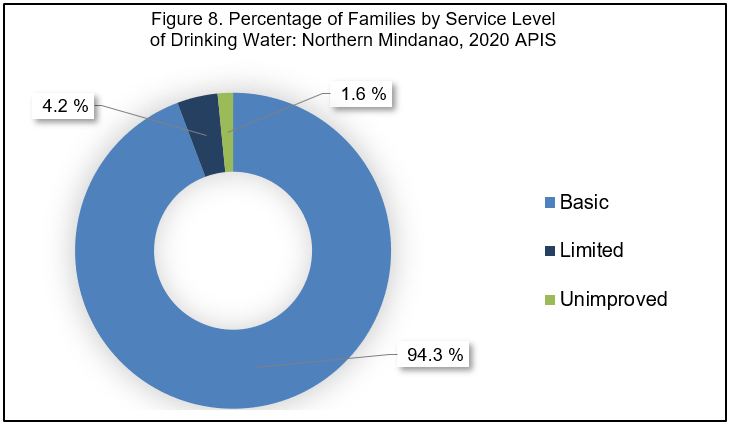
Social Insurance Program
On social insurance program, Northern Mindanao had about four in every ten families as members/dependents/beneficiaries of the Social Security System (SSS). This was followed by membership to health/Medical Insurance other than Philhealth or the HMO at 10.9 percent. Membership in Government Service Insurance System (GSIS) was at 7.7 percent, Life Insurance/Pre-need Insurance at 6.3 percent, and Overseas Workers Welfare Administration (OWWA) at 3.9 percent. (Figure 9)
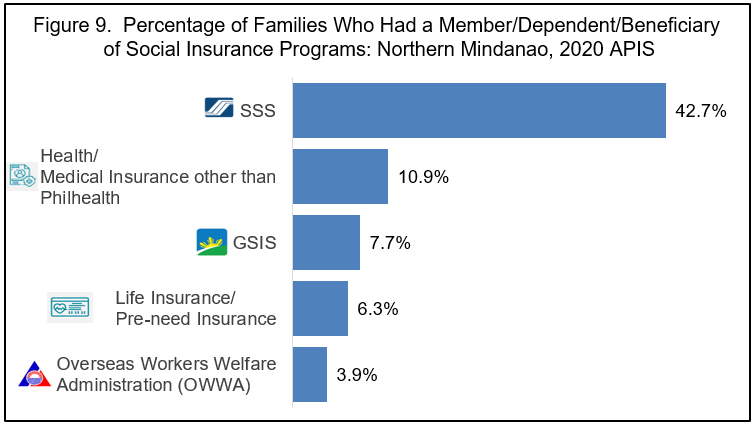
TECHNICAL NOTES
Introduction
The Annual Poverty Indicators Survey (APIS) is a nationwide sample survey designed to provide information on the different indicators related to poverty. This survey is a joint undertaking of the National Statistics Office, World Bank Mission and the United Nation Development Program.
Survey Objectives
The APIS aims to provide inputs to the development of an integrated poverty indicator and monitoring system which would enhance timely, accurate and consistent production of poverty-related data that can be used at the national level.
It also aims to supplement the identification of the poor families through the use of non-income indicators. Hence, this survey provides information on the socio-economic profile of families and other information relating to their living conditions. More specifically, this survey gathers information for the 78 provinces and all cities and municipalities of Metro Manila on the demographic and economic characteristics, health status and education of the family members; awareness and use of family planning methods; housing, water and sanitation condition of the families; availment of credit to finance the family business or enterprise; and income and expenditures of the family. In addition, it gathers information on the effect of the economic crisis in families and the steps they had taken in response to these problems.
Definitions of Terms and Concepts
Demographic Characteristics ask information on the demographic characteristics of each family member such as relationship to the family head, sex, age and highest grade completed.
Health Status obtains information on the types of illnesses experienced by the family and the type of health facilities that they are visiting or consulting in case of illness or something pertaining to their family health.
Schooling Status determines the educational attainment of the family members 5 years old and over; it also determines whether a family member aged between 6-24 years are currently attending formal school and if not, the reason for not currently attending school.
Economic Characteristics obtains information on the employment status of each family member 5 years old and over; it also includes questions on the number of days worked during the past quarter and salaries and wages from employment of each working family member.
Family Planning assesses the knowledge of the married women in the family regarding family planning.
Housing and Sanitation obtains information that relates to housing characteristics and household amenities owned by the family.
Credit Information obtains information on the availment of credit needed in the operation of economic activities.
Impact of Financial Crisis determines the perception of the family regarding the effect of some economic problems on their family living.
Family Sustenance determines whether or not the family is engaged in the family sustenance activities, which is for home consumption only, in order to augment family income.
Net Share of Crops, Fruits and Vegetables Produced or Livestock and Poultry Raised by Other Household determines whether or not the family has received a share on crops, fruits, vegetables, etc. which were raised and harvested by other households, in terms of produce or in cash.
Entrepreneurial Activities determine if any member of the family is engaged as operator or self-employed in any agricultural or non-agricultural family-operated activities.
Other Sources of Income obtain information on other sources of family income not derived from work.
Other Receipts obtain information on the sources of non-income receipts of families, that is, those that do not come from earnings, property income and gifts received.
Family Expenditures determine the expenses made by the family purely for personal consumption.
Class of Worker refers to the relationship of the worker to the establishment in which he works.
Earnings refer to gross salary or wage whether in cash or in kind. This include deductions made for retirement, insurance premiums, social security, pension dues, PAG-IBIG fund, MEDICARE, salary loans and other deductions reflected in the payroll.
Earnings in cash include cash commissions, tips, bonuses, cost of living allowance (COLA), Personal Relief Allowance (PERA) and other allowances in cash for family living such as transportation and representation allowance, clothing, housing (given in cash), overtime pay, longevity pay, commissions and medical benefits, etc.
Earnings in kind refer to those received by the employee/paid worker in the form of goods like free medicines, rice, meat, fish, clothing, free housing, free bus service, etc., as remuneration for his services/work.
Family is an aggregate of persons bound by ties of kinship, which live together under the same roof and eat together or share in common the family food. It covers both the nuclear family and the extended family. In cases where persons not related with each other by blood, marriage or adoption are in the same household, only the head of the household is considered. This case is a single person family.
Highest grade completed refers to the highest grade or year completed in school, college or university.
Occupation refers to the type of work, trade or profession performed by the individual during the reference period such as palay farmer, typists, physician, beauticians, etc. If he is not at work, it refers to the kind of work he was doing or will be doing if merely waiting for a new job to begin within two weeks from the date of interview.
Primary job/business is any gainful activity of a person which is a permanent and full time job, lasting for one (1) year or longer or had lasted or expected to last for one year or longer, regardless of whether he had a job/business at work or not during the reference past week.
Respondent is a knowledgeable member of the sample family who can provide accurate answer to most of the questions in this survey.
Usual Occupation of economically active population refers to the kind of job or business which they were engaged in most of the time during the past 12 months such as palay farmer, elementary school teacher, medical clerk, sari-sari store proprietor, etc.; for the economically inactive population, it would be housewife, student, pensioner, retired, disabled, dependent, etc., as the case maybe.
Work is any economic activity that a person does for pay, in cash or in kind, in any establishment, office, farm, private home or for profit or without pay on family farm or enterprise.

